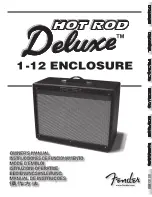
Power Indicator
-
When the LED is red, the Speedwoofer is in standby mode. After receiving a signal, the
LED turns green or blue (depending on version of Speedwoofer) and your subwoofer is in operation
mode. No light means the sub isn't receiving power. Re
-
check the power switch and AC power connec-
tion. For standby to function, the auto power switch must be set to on.
Wireless Pairing Switch
-
To use your Speedwoofer wirelessly, you'll need the optional wireless trans-
mitter. To pair the Speedwoofer, refer to the instructions included with the transmitter.
Volume
-
Controls the volume of bass output. During setup, we suggest setting the volume control near
the 12 o'clock position. This allows maximum flexibility if you need to perform fine volume adjustments
later. If you find that you have to turn the volume up too high or down too low, refer to the setup in your
A/V receiver to adjust the its output level to the subwoofer.
Crossover
-
DSP Settings –
The crossover knob selects both the crossover frequency and also lets you
select from 2 DSP sound modes. If the knob is turned fully counterclockwise until it clicks (LFE enabled),
the internal crossover of the Speedwoofer is bypassed and the crossover function will be handled by your
home theater receiver or processor. Also, with the Speedwoofer
’
s crossover bypassed, the DSP mode will
extend the Speedwoofer
’
s bass response. This is ideal for home theater.
If the knob is rotated clockwise off the bypass position, the Speedwoofer
’
s crossover is active, and you
can select the appropriate frequency. For example, an 80Hz setting means your Speedwoofer will handle
all frequencies at 80Hz and below. An 80Hz setting is recommended for larger bookshelf speakers. For
smaller bookshelf speakers, we recommend a setting of 90
-
100Hz. We also suggest listening with differ-
ent crossover settings so the Speedwoofer integrates seamlessly with the rest of your system.
Also, with the internal crossover active, the DSP will enable your Speedwoofer to deliver the same perfor-
mance as our original Speedwoofer 10S. This may be a good choice if you primarily listen to music or if
you wish to limit the bass that is transmitted to other rooms. To use this mode with your home theater
receiver
’
s internal crossover also active, turn the crossover knob fully clockwise. This will prevent the in-
ternal crossover from interfering with your home theater receiver
’
s crossover.
Phase
-
Allows you to slightly delay the bass through the subwoofer, which can help the subwoofer blend
perfectly with the rest of your system. The bass should sound like it
’
s coming from your front speakers
instead of a separate subwoofer. The standard setting is 0 degrees, but feel free to experiment.
Auto Power
-
In the auto power on position, the Speedwoofer will remain in standby mode until it re-
ceives an audio signal. The power indicator will change from red to green and the Speedwoofer is in oper-
ation mode. In the auto power off position, the Speedwoofer will always stay in operation mode, which
will not harm the subwoofer.
Line In/LFE In
-
LFE stands for low frequency effects. For home theater, use a single RCA cable from the
receiver's subwoofer or LFE out to the Speedwoofer's LFE in. For a 2 channel system, use a stereo pair of
RCA cables to the Speedwoofer's line In left and right inputs.
Line Out
-
Can be used for 2 different purposes. For a 2 channel system, this can feed the signal back to
your stereo amplifier for the other speakers. The line outs can also be used to connect an additional
Speedwoofer. See the Dual Speedwoofer section.
Speaker Level In
-
This connection can be used in stereo systems with amplifiers that do not have pre
-
amplifier outputs. In this case, you can connect one set of speaker wires to your Speedwoofer and anoth-
er stereo set to your main speakers. Use the Speedwoofer
’
s internal crossover.
If you experience ground
-
loop hum, this is not the fault of the subwoofer. It is the result of differences in
the ground characteristics between different audio equipment. Fortunately, this is easy to fix. Connect a
length of wire from your audio amplifier
’
s ground to the Speedwoofer amplifier
’
s ground. If your audio
amplifier does not have a ground lug, then loosen a screw around the perimeter of the chassis. Wrap the
stripped end of the wire around the screw and re
-
tighten. The hum should vanish.
2






















